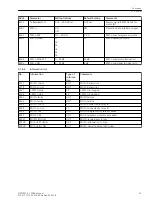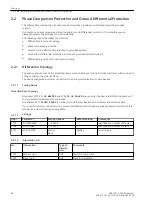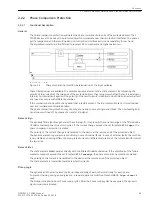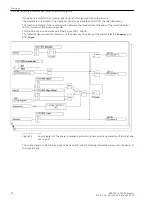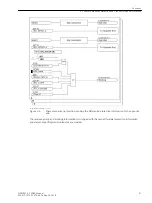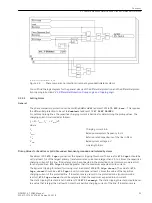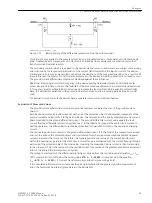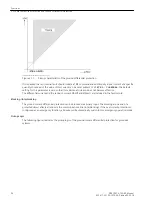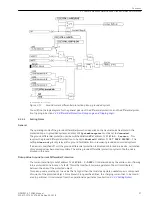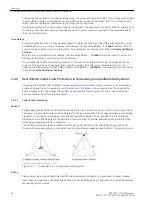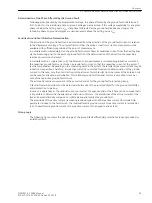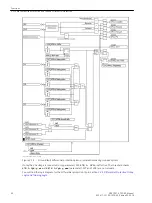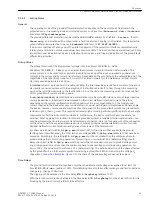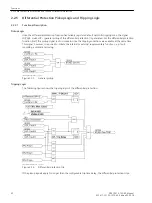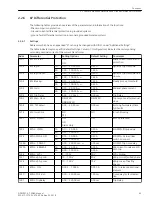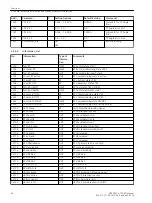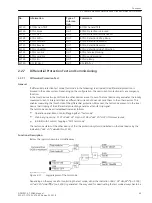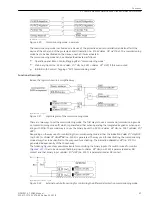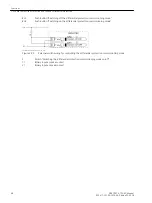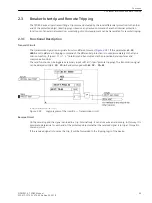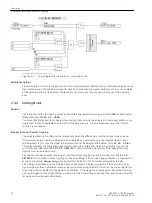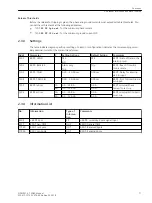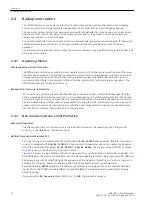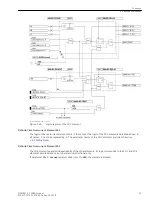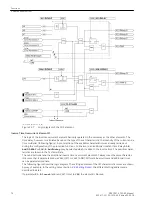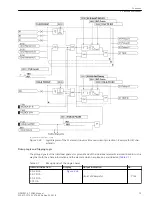
Setting Notes
General
The operating mode of the ground differential protection depends on the neutral point treatment in the
protected zone. In resonant-grounded or isolated system, you have to set
Peterson-C.Gnd.
or
Isolated
at address 207
SystemStarpoint
.
The ground differential protection can be switched
ON
or
OFF
at address 1221
87N L: Protect.
. If set to
Alarm only
, an indication will be output when a fault is detected. Tripping is not initiated. This requires the
ground differential protection to be set to
Enabled
at address 112
87 DIFF.PROTEC.
.
If a device is switched off at any end of the protected object or if the protection interface communication is
interrupted, a calculation of measured values becomes impossible. The function then operates locally and only
issues directional indications and pickup indications but no pickup and tripping indications of the ground fault
differential protection.
Pickup Values
The pickup threshold of the displacement voltage is set in address 1226
87N L: 3V0>
.
At address 1229
87N L: IN(s)>
you can enter the minimum current for direction determination. The
pickup current is to be set as high as possible to avoid false pickup of the device provoked by unbalanced
currents in the system and by current transformers. Dependent on the grounding of the network starpoint, the
magnitude of the capacitive ground fault current (for isolated networks) or the wattmetric residual current
(for compensated networks) is decisive.
In isolated systems, a ground fault in a cable will allow the total capacitive ground fault currents of the entire
electrically connected system, with the exception of the faulted cable itself, to flow through the measuring
point as the latter flows directly to the fault location (i.e. not back via the measuring point). Enter about half
of this ground fault current as pickup value.
In resonant-grounded systems directional determination is made more difficult since a much larger reactive
current (capacitive or inductive) is superimposed on the critical wattmetric (active) current. Therefore,
depending on the system configuration and the position of the arc-compensating coil, the total ground
current supplied to the device may vary considerably in its values with regard to magnitude and phase angle.
The device, however, must evaluate only the active component of the ground fault current, the ground fault
residual current, that is
Ι
N
·cosφ. This requires extremely high accuracy, particularly with regard to phase angle
measurement of all the instrument transformers. Furthermore, the device must not be set to operate too
sensitive. When applying this function in resonant-grounded systems, a reliable direction determination can
only be achieved when toroidal current transformers are connected. Here the following rule of thumb applies:
set the value to half the expected measured current, whereby only the residual wattmetric current is used.
Residual wattmetric current predominantly derives from losses of the Petersen coil.
For phase determination
87N L:Vph-g min
(address 1227) is the criterion that applies to the ground-
faulted phase if simultaneously the other two phase voltages
87N L:Vph-g max
(address 1228) have been
exceeded. Accordingly, the setting
87N L:Vph-g min
must be set smaller than the minimum phase-to-
ground voltage that occurs during operation. This setting, too, is uncritical. 40 V (default setting) should
always be correct.
87N L:Vph-g max
must be greater than the maximum phase-to-ground voltage occur-
ring during operation, but less than the minimum phase-to-phase voltage occurring during operation. For
V
Nom
= 100 V, the value must therefore be 75 V (default setting). The definite detection of the phase affected
by the ground fault is a further prerequisite for alarming a ground fault. When connecting the voltage V
0
(Appendix
), the check of the phase voltages does not take place.
Time Delays
The ground fault is detected and reported only when the displacement voltage has applied for at least the
time
87N L:TD-F.det.
(address 1230). This stabilizing time also takes effect when ground fault conditions
change (e.g. change of direction).
The tripping can be delayed via the time delay
87N L:TripDelay
(address 1231).
With the inrush current restraint activated, the time delay
87N L:TripDelay
must be at least 20 ms for the
blocking by the inrush current restraint to be effective.
2.2.4.2
Functions
2.2 Phase Comparison Protection and Ground Differential Protection
SIPROTEC 4, 7SD80, Manual
61
E50417-G1100-C474-A2, Edition 02.2018
Summary of Contents for SIPROTEC 4 7SD80
Page 8: ...8 SIPROTEC 4 7SD80 Manual E50417 G1100 C474 A2 Edition 02 2018 ...
Page 10: ...10 SIPROTEC 4 7SD80 Manual E50417 G1100 C474 A2 Edition 02 2018 ...
Page 18: ...18 SIPROTEC 4 7SD80 Manual E50417 G1100 C474 A2 Edition 02 2018 ...
Page 248: ...248 SIPROTEC 4 7SD80 Manual E50417 G1100 C474 A2 Edition 02 2018 ...
Page 298: ...298 SIPROTEC 4 7SD80 Manual E50417 G1100 C474 A2 Edition 02 2018 ...
Page 312: ...312 SIPROTEC 4 7SD80 Manual E50417 G1100 C474 A2 Edition 02 2018 ...
Page 322: ...322 SIPROTEC 4 7SD80 Manual E50417 G1100 C474 A2 Edition 02 2018 ...
Page 400: ...400 SIPROTEC 4 7SD80 Manual E50417 G1100 C474 A2 Edition 02 2018 ...
Page 402: ...402 SIPROTEC 4 7SD80 Manual E50417 G1100 C474 A2 Edition 02 2018 ...

